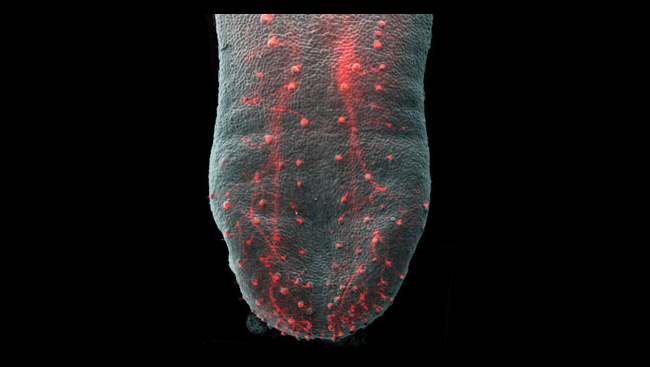A Matter of Taste
- Published1 Sep 2011
- Reviewed1 Sep 2011
- Author Susan Perry
- Source BrainFacts/SfN
Why do some people enjoy the taste of broccoli while others find it bitter and unpleasant? Why do some seek out spicy and tangy meals on a restaurant’s menu while others stick with the bland and familiar? New research is uncovering the neurobiological and genetic sources of taste preferences, which can influence not just eating habits but also health.

During development, sensory nerves (shown in red) form the connections between taste buds (also shown in red) and the rest of the nervous system. Later, taste information is carried along these nerves to the brain.
When we sit down to devour our favorite meal, we take for granted that we will be able to taste and savor the different flavors in the food. Our sense of taste is so central to our daily lives that we seldom think about it. But taste, as scientists are discovering, is anything but ordinary. It’s a highly complex neurobiological process influenced by many factors, including genes, age, and experience.
Scientists believe taste evolved to protect us from eating things that are poisonous and to ensure we get the calories and nutrients we need. Many poisons are either bitter or sour — tastes we tend to reject. Enjoyment of salty and sweet-tasting foods, on the other hand, ensures we meet our nutritional requirements for salts (especially sodium chloride) and carbohydrates (including sugars). A fifth taste, umami (Japanese for “savory”), encourages us to eat foods rich in glutamate, an amino acid found in meats, cheeses, and tomatoes. Some scientists believe humans have a sixth basic taste — for fat.
But what gives some people a low sensitivity and others a high sensitivity to certain tastes? To answer this and other questions about the sensation of taste, neuroscientists are studying its receptor cells and their genetic influences. Such research is leading to:
- Insight into how the brain processes sensory stimuli.
- Identification of factors that influence taste preference.
- More effective strategies for helping people avoid overeating and becoming obese.
Taste begins in the mouth, where each of us has between 5,000 and 10,000 taste buds. Most taste buds are located within the tongue’s small, visible bumps — or papillae — but some can be found in other areas of the mouth and throat. Each taste bud contains 50 to 100 taste receptor cells — brain cells called neurons that transmit taste information. When we eat a strawberry, for example, saliva dissolves the fruit’s chemicals, which then enter into the central pores of the taste buds and bind to the taste cells. The cells quickly send “sweet” and “sour” taste messages from these chemicals through nerve fibers to the brain, where they eventually reach the sensory cortex. However, the flavor of “strawberry” requires the addition of information gained through smell.
How sensitive we are to sweetness, bitterness, or any other taste depends on our genetic makeup. For example, variants of one gene, TAS2R38, help determine how strongly an individual will be able to detect some bitter tastes, and may explain why some people have a strong dislike of broccoli and other cruciferous vegetables. Research also has shown that certain individuals, dubbed “supertasters,” inherit more taste buds and receptor cells than other people. Because tastes are more intense for them, they tend to avoid powerfully flavored foods, including sugary desserts. But supertasters use more salt than other people, apparently to block the bitter taste of certain foods.
The sense of taste affects individual food choices and eating habits. It may therefore play a significant role in overeating and in the rising incidence of obesity, diabetes, and related disorders. Research suggests, for example, that people who have a low sensitivity to the taste of fat tend to eat more fatty foods and are more likely to be overweight. Other animal research shows glucagon, a chemical involved in stabilizing blood sugar, affects sensitivity to sugary tastes in mice. Such findings may help scientists develop weight-loss programs based on identifying specific taste sensitivities.
Genetics isn’t the only factor behind taste preferences, though. Age also plays a role. We begin to lose some of our taste buds permanently as we pass through middle age, a development that can make food taste bland and eating less enjoyable. Illness and infection also can dull and deaden taste buds or the nerve pathways that send taste messages to the brain.
Experience influences our taste preferences as well. Salt, for example, is an acquired taste. The more we use on our foods, the more we crave it. Cultural influences on taste appear to be determined early in life, perhaps even in the womb. Research suggests, for example, that mothers pass their food preferences on to their babies through amniotic fluid — a finding that may explain, along with genetics, why children in different cultures thrive on such a wide variety of foods.
Although many aspects of taste preference differ from person to person, some people are born with rare deficits in taste. Taste disorders also can result from injury or illness. Ageusia (loss of taste) or dysgeusia (distorted taste) are serious disorders that can lead to depression, weight problems, nutritional deficiencies, and a lower quality of life.
We may take our sense of taste for granted, but as scientists are discovering, taste is an important sensory experience that influences our health as well as our culinary appetites.
CONTENT PROVIDED BY
BrainFacts/SfN
Also In Archives
Trending
Popular articles on BrainFacts.org


















